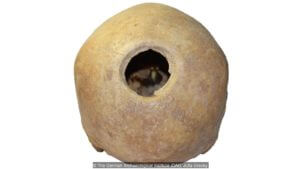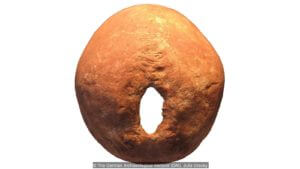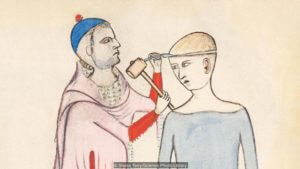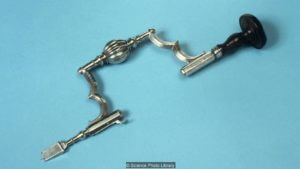
Trepanation: Why our ancestors drilled holes in their skulls
 26. 03. 2019
26. 03. 2019

During a long human prehistory, people around the world performed a trepation of the skull, a rough surgical procedure in which they made a skull hole to live people. Either by drilling or by cutting or scratching the bone layers with sharp tools. Today, archaeologists have uncovered thousands of skulls with signs of trepanation during excavations around the world. However, despite their obvious importance to the procedure, the experts are not united in its purpose.
What was the purpose trepanation
The reasoning of anthropologists is based on the experience of trepanations performed in the 20th century in Africa and Polynesia. Trepanations were to eliminate mainly pain caused by skull injuries or neurological diseases. Trepanations probably had the same purpose in prehistory. Many trepanated skulls showed clear signs of cranial injuries or neurological problems, as the trepanation opening of the skull was at the site of this problem.
Trepanations were performed both for medical reasons and by our ancestors for ritual reasons. The oldest direct evidence of trepanation dates back to about 7 BC. It was practiced in several different places in ancient Greece, North and South America, Africa, Polynesia and the Far East. Thus, humans have developed and performed trepanation independently in different parts of the Earth. However, most social cultures abandoned it in the late Middle Ages, but its practice persisted in remote areas of Polynesia and Africa until the early 000th century.

Trepanace 20 - 25 year old girls. The hole healed only slightly (© The German Archaeological Institute (DAI), Julia Gresky)
Already the first published studies in the 19th century on trepanations said that the implementation of trepanations on prehistoric inhabitants was of a spiritual nature. The purpose was to allow entry into the skull or release of the passage of ghosts into the human body, or it was also part of the initiation ritual. However, it is very difficult today to prove the medical purpose by shaking, because the human brain left no traces on the remains of the skull. But even so, the best evidence ever discovered of their ritual purpose has been found in a small area of Russia.
Discovery of the site
The story begins in 1997. Archaeologists have discovered graves on the northern coast of the Black Sea, in the area of Rostov-on-Don. The site contained the skeletal remains of 35 people scattered in twenty graves. According to the method of burial, scientists estimate that the graves date from between 5 and 000 BC, the Bronze Age.
One of the graves contained the skeletons of five adults - three male and two female skeletons, along with a children's skeleton between the ages of one and two years and a girl about the age of a teenager. Finding more skeletons in one grave is not unusual. However, the skulls of two men and two women, including an immature girl, were shaking. Each skull had one centimeter-wide hole with a perfect elliptical shape. The holes were scraped at the edges, and only one male skull bore signs of pushing and scratching, but the hole was no longer drilled. Only the infant's skull showed no signs of trepanation.
Elena Batieva
Anthropologist Elena Batieva of the Southern Federal University in Rostov-on-Don, who was investigating the case, immediately understood the unusual nature of such trepanation. It was created exactly on the same area of the skull, called the obelion, which is the posterior apex of the skull, at the site of the skull seams. A site such as the obelion is very unusual for trepanation, with less than 1% of similar trepanations known at all. So far, only one skull with such trepanation has been found in this area in 1974, very close to the area of the later find. But the discovery of five identical trepanations is completely unprecedented.
The unusualness of performing trepanation in the obelion is simple. It is very dangerous. The obelion lies directly above the area called the superior sagital sinus, where blood collects in the brain before it drains into the main cerebral vein. By opening the skull at this point, the operator risks massive bleeding resulting in death. This means that the ancient ancestors of the Bronze Age in Russia must have had a very important reason for such trepanation. Especially when the skeletons showed no injury or disease before or after trepanation. In other words, these people were in perfect physical condition, so why was they trepanated? Is this evidence of part of a ritual? That would be an interesting option. However, E. Batatia had to give up this theory. Although she had analyzes of many skeletons from southern Russia, she could not afford to create theories on the basis of just a few skulls, however secret these skulls may be.
Searching in archives
E. Batieva therefore decided to examine all unpublished records in Russia from archaeological excavations concerning the unusual shaking of skulls in the area of the obelion. Surprisingly, she was successful. She found two more cases of skull trepanation in the obelion in previously found skulls. One dates from 1980 and the other from 1992. Each of them was discovered in a place about 50 kilometers away from Rostov, but in their case it was a medical procedure. Thus, E. Batatia had a total of 8 cases found in a small area of southern Russia, probably dating from the same period.

Trepanation Women 30 - 35 Years. The hole is healed. (© The German Archaeological Institute (DAI), Julia Gresky)
In 2011, an international team of archaeologists analyzed 137 human skeletons. These were lifted from three burial sites from the Bronze Age in the southeastern region about 500 kilometers around Rostov-on-Don, in the Stavropol region, near today's border with Georgia. The primary purpose was to examine the health of the population, but of the 137 skulls found, 9 had a significant hole. Five of them were standard examples of trepanations. Holes were drilled in various variations on the anterior and lateral parts of the skull, and these skeletons bore clear signs of physical discomfort, so that trepanations were to be used to treat these injuries. However, the remaining four skeletons had no signs of injury or disease, and their skulls were trepanated exactly at the point of the obelion.
Coincidentally, a researcher - anthropologist Julia Greska from the German Anthropological Institute (DAI) - has already read a treatise on trepanations in the Rostov area by E. Batieva. Only now have E. Batatva and J Gresky, along with other archaeologists, described all 12 skull tremors in the obelion. Their study was published in April 2016 in a journal American Journal of Physical Anthropology.
Trepanation was widespread
The discovery of 12 such skulls is absolutely extraordinary, no matter where they are discovered. And the fact that they were found in a tiny large area of Russia offers a very probable connection between them. If there is no connection between them, then, given the occasional trepanation performed in such quantities and to this extent, it appears to be extremely low. E Batieva and J. Gresky, together with their colleagues, know that it is very difficult to prove the theory of the center of ritual trepanations in southern Russia, but such a group of skulls with unusual trepanations offers this theory.
The expert on trepanation in Russia is Marie Mednikova from the Moscow Academy of Sciences. M. Medniková believes that trepanation in a specific and dangerous area of cranium was performed to obtain a certain kind of transformation. He believes that trepanations in this area of the skull served to gain extraordinary abilities that the general population did not have. So we can only speculate why these 12 healthy people underwent an unusual and dangerous trepanation. But thanks to these very trepanation holes, we can think about the fate of the people who underwent trepanation.
One of the 12 skulls with trepanation, buried in the Rostov locality, belonged to a young woman, about 25 years old. Her skull showed no signs of healing. From this it can be concluded that the woman died either during the operation or shortly after it. However, the remaining skulls showed that their owners survived the operation. The bones of these skulls had healed edges of the holes, although the bone never fully grew. Three of these 12 skulls showed only a slight healing, which means that these individuals survived the operation by about two to eight weeks. These skulls belonged to women between the ages of 20 and 35. The third person was older, aged between 50 and 70, whose gender could not be identified. Another eight skulls showed relatively advanced healing of the hole, from which it can be concluded that these individuals survived the operation for about another 4 years.
Was trepanation a ritual?
The fate of the first people from the mass grave, who captivated E. Batieva with their bizarre trepanation, is also interesting. Two men and two women and a young, adolescent girl survived with their hole for years. The estimated age of a minor girl is about 14 to 16 years. This means that she was trepanated at about the age of 12 or earlier. Of course, there is still the possibility that these people suffered from an illness or suffered some injuries, and eight of them probably really helped. But it is also possible that E. Batieva and her colleagues are right when they claim trepanation as a purely ritual act. What benefit it brought to the operated individuals, if there was one at all, can hardly be guessed.





 6
6


